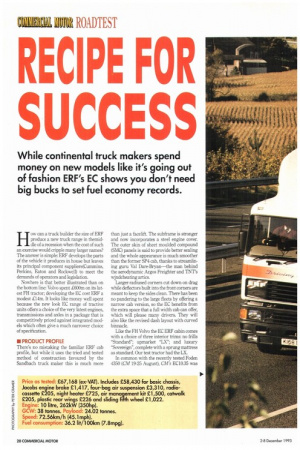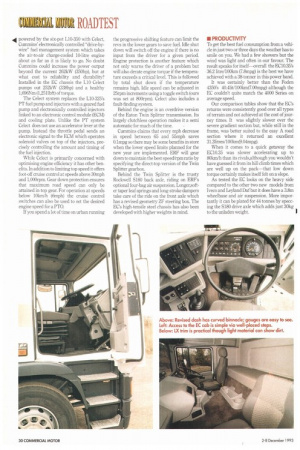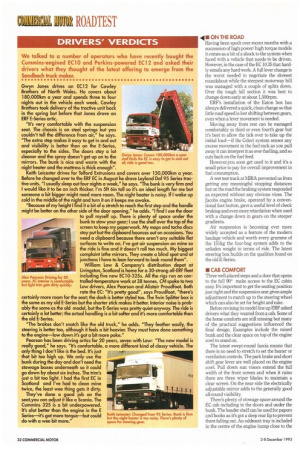CIPE FOR SUCCESS
Page 30

Page 32

Page 34

Page 35

If you've noticed an error in this article please click here to report it so we can fix it.
While continental truck makers spend money on new models like it's going out of fashion ERF's EC shows you don't need big bucks to set fuel economy records.
How can a truck builder the size of ERF produce a new truck range in themiddie of a recession when the cost of such an exercise would cripple many larger names? The answer is simple: ERF develops the parts of the vehicle it produces in house but leaves its principal component suppliers(Cununins, Perkins, Eaton and Rockwell) to meet the demands of operators and legislation.
Nowhere is that better illustrated than on the bottom line: Volvo spent £600m on its latest FH tractor; developing the EC cost ERF a modest £14m. It looks like money well spent because the new look EC range of tractive units offers a choice of the very latest engines, transmissions and axles in a package that is competitively priced against integrated models which often give a much narrower choice of specification.
• PRODUCT PROFILE There's no mistaking the familiar ERF cab profile, hut while it uses the tried and tested method of construction favoured by the Sandbach truck maker this is much more than just a facelift. The subframe is stronger and now incorporates a steel engine cover. The outer skin of sheet moulded compound (SMC) panels is said to provide better sealing and the whole appearance is much smoother than the former SP4 cab, thanks to streamlining guru Val Dare-Bryan—the man behind the aerodynamic Argos Freighter and TNT's windcheating artics.
Larger-radiused corners cut down on drag while deflectors built into the front corners are meant to keep the sides clean. There has been no pandering to the large fleets by offering a narrow cab version, so the EC benefits from the extra space that a full width cab can offer, which will please many drivers. They will also like the revised dash layout with curved binnacle, Like the FH Volvo the EC ERF cabin comes with a choice of three interior trims: no frills "Standard"; upmarket "LX"; and luxury "Sovereign", complete with a sprung mattress as standard. Our test tractor had the LX.
In common with the recently tested Foden 4350 (CM 19-25 August), CM'S EC10.35 was
powered by the six-pot L10-350 with Celect, Cummins' electronically controlled "drive-bywire fuel management system which takes the air-to-air charge-cooled 10-litre engine about as far as it is likely to go. No doubt Cummins could increase the power output beyond the current 262kW (350hp), but at what cost to reliability and durability? Installed in the EC chassis the L10 Celect pumps out 252kW (338hp) and a healthy 1,696Nm (1,2511bft) of torque.
The Celect system replaces the L10-325's PT fuel pump and injectors with a geared fuel pump and electronically controlled injectors linked to an electronic control module (ECM) and cooling plate. Unlike the PT system Celect does not use an accelerator lever at the pump. Instead the throttle pedal sends an electronic signal to the ECM which operates solenoid valves on top of the injectors, precisely controlling the amount and timing of the fuel injection.
While Celect is primarily concerned with optimising engine efficiency it has other benefits. In addition to limiting top speed it offers foot-off cruise control at speeds above 30mph and 1,000rpm. Gear down protection ensures that maximum road speed can only be attained in top gear. For operation at speeds below 10krn/h (6mph) the cruise control switches can also be used to set the desired engine speed for a PTO.
If you spend a lot of time on urban running
the progressive shifting feature can limit the revs in the lower gears to save fuel. Idle shut down will switch off the engine if there is no input from the driver for a given period. Engine protection is another feature which not only warns the driver of a problem but will also derate engine torque if the temperature exceeds a critical level. This is followed by total shut down if the temperature remains high, Idle speed can be adjusted in 25rpm increments using a toggle switch (ours was set at 800rpm). Celect also includes a fault-finding system.
Behind the engine is an overdrive version of the Eaton Twin Splitter transmission. Its largely clutchless operation makes it a semi automatic for much of the time. • Cummins claims that every mph decrease in speed between 65 and 55mph saves 0.1mpg so there may be some benefits in store when the lower speed limits planned for the new year are implemented. ERF will gear down to maintain the best speed/rpm ratio by specifying the direct-top version of the Twin Splitter gearbox.
Behind the Twin Splitter is the trusty Rockwell S160 back axle, riding on ERF's optional four-bag air suspension. Longer,softer taper leaf springs and long-stroke dampers take care of the ride on the front axle which has a revised geometry ZE steering box. The EC's high-tensile steel chassis has also been developed with higher weights in mind.
• PRODUCTIVITY
To get the best fuel consumption from a vehicle in just two or three days the weather has to smile on you. We had a few showers but the wind was light and often in our favour. The result speaks for itself—overall the EC10.35's 36.2 litre/100km (7.8mpg) is the best we have achieved with a 38-tonner in this power band.
It was certainly better than the Foden 4350s 40.41it/1001trri(7.00mpg) although the EC couldn't quite match the 4000 Series on average speed.
Our comparison tables show that the EC's returns were consistently good over all types of terrain and not achieved at the cost of journey times. It was slightly slower over the severe gradient section but, while still in the frame, was better suited to the easy A road section where it returned an excellent 31.31itres/1001cm(9.04mpg).
When it comes to a quick getaway the EC10.35 was slower accelerating up to 80k.m/h than its rivals,although you wouldn't have guessed it from its hill climb times which are well up on the pack—that low down torque certainly makes itself felt on a slope.
As tested the EC looks on the heavy side compared to the other two new models from Iveco and Leyland Daf but it does have a 3.8m wheelbase and air suspension. More importantly it can be plated for 44 tonnes by speccing the S180 drive axle which adds just 30kg to the unladen weight.
• ON THE ROAD
Having been spoilt over recent months with a succession of high power/ high torque models it comes as a bit of a shock to the system when faced with a vehicle that needs to be driven. However, in the case of the EC 1035 that hardly entails any hard work. A full lever change is the worst needed to negotiate the slowest roundabout while the steepest motorway hill was managed with a couple of splits down, Over the tough hill section it was best to change down early at about 1,500rpm.
ERFs installation of the Eaton box has always delivered a quick, clean change so that little road speed is lost shifting between gears, even when a lever movement is needed.
Moving away from rest can be managed comfortably in third or even fourth gear but it's best to allow the tick over to take up the initial load—if the Celect system senses any excess movement in the fuel rack as you pull away it can interpret it as over-fuelling, and so cuts back on the fuel feed.
However,you soon get used to it and it's a small price to pay for overall improvement in fuel consumption.
A wet test track at MIRA prevented us from getting any meaningful stopping distances but on the road the braking system responded as expected without any obvious vices. The Jacobs engine brake, operated by a conventional foot button, gave a useful level of check braking and even more retardation when used with a change down in gears on the steeper gradients.
Air suspension is becoming ever more widely accepted as a feature of the modern haulage vehicle and worth every gramme of the 151kg the four-bag system adds to the unladen weight in terms of ride. The latest steering box builds on the qualities found on the old E-Series.
• CAB COMFORT
Three well-placed steps and a door that opens to the full 90° make access to the EC cabin easy. It's important to get the seating position just right and the suspension seat gives ample adjustment to match up to the steering wheel which can also be set for height and rake.
Before revising its model line up ERF asked drivers what they wanted from a cab. Some of the home comforts are still missing but many of the practical suggestions influenced the final design. Examples include the raised bunk and the clear space on top of the engine cowl to stand on.
The latest swept-round fascia means that there is no need to stretch to set the heater or ventilation controls. The park brake and short shift gear lever are well placed on the engine cowl. Pull down sun visors extend the full width of the front screen and when it rains there are three wiper blades to maintain a clear screen. On the near side the electrically adjustable mirror adds to the generally good all-round visibility.
There's plenty of stowage space around the EC cab including in the doors and under the bunk. The header shelf can be used for papers and books as it's got a deep rear lip to prevent them falling out. An oddment tray is included in the centre of the engine hump close to the single bunk which is raised up so that the occupant can sit on it. It's a pity that there isn't also an exterior locker for jacks and chains, which most drivers don't want inside the cab with them.
Of all the advances in vehicle design noise suppression must rate among the most important.
Inside the cab noise levels have been reduced year by year to the point that many saloon cars would do well to emulate them. Even so, the ERF ECl0.35 is particularly quiet. • SUMMARY The EC10.35 tractor will appeal to operators and drivers alike. The Cummins L10-350 makes it a willing, economical workhorse which competes in carrying capacity with the latest models from Iveco and Leyland Dal.
ERF's SMC cab construction is well proven and even if the paint is stone chipped it won't rust which will help residual values. Inside the new cab is roomy, bright and uncluttered. Priced at £58,430 list the EClOcan't claim to be the cheapest in its class but then you must expect to pay a little extra for quality.
Can ERF compete shoulder to shoulder with the best of the Continentals? Judging by our first taste of the new EC the answer is a resounding yes.
7 by Bill Brock




















































































